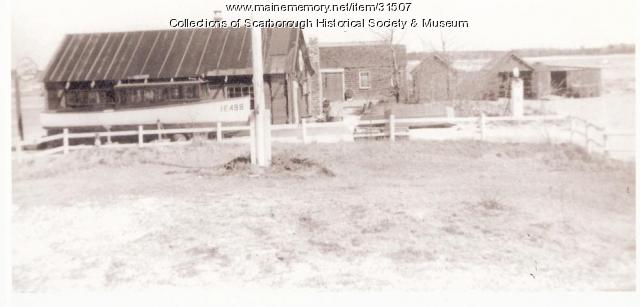Keywords: ship launches
Item 82113
Schooner Elizabeth W. Nunan launch in East Boothbay, July 1908
Contributed by: Boothbay Region Historical Society Date: 1908 Location: East Boothbay Media: Photographic print
Item 20563
Contributed by: Pejepscot History Center Date: circa 1880 Location: Brunswick; Harpswell Media: Photographic print
Exhibit
The Doris Hamlin, a four-masted schooner built at the Frye-Flynn Shipyard in Harrington, was one of the last vessels launched there, marking the decline of a once vigorous shipbuilding industry in Washington County.
Exhibit
The Schooner Bowdoin: Ninety Years of Seagoing History
After traveling to the Arctic with Robert E. Peary, Donald B. MacMillan (1874-1970), an explorer, researcher, and lecturer, helped design his own vessel for Arctic exploration, the schooner <em>Bowdoin,</em> which he named after his alma mater. The schooner remains on the seas.
Site Page
Thomaston: The Town that Went to Sea - Henry Knox: Shipping
"Henry Knox: Shipping Shipping the goods that he was producing was an important part of Knox’s business dealings."
Site Page
Scarborough: They Called It Owascoag - Maritime Tales: Shipyards and Shipwrecks - Page 1 of 2
"Some ships were built elsewhere, but launched at Dunstan Landing. Such was the Sarah, built by Major John Waterhouse near Scottow Hill and hauled…"
Story
How 20 years in the Navy turned me into an active volunteer
by Joy Asuncion
My service didn't end when I retired from the Navy
Story
My father, Earle Ahlquist, served during World War II
by Earlene Chadbourne
Earle Ahlquist used his Maine common sense during his Marine service and to survive Iwo Jima
Lesson Plan
Longfellow Studies: Longfellow Amongst His Contemporaries - The Ship of State DBQ
Grade Level: 9-12
Content Area: English Language Arts, Social Studies
Preparation Required/Preliminary Discussion:
Lesson plans should be done in the context of a course of study on American literature and/or history from the Revolution to the Civil War.
The ship of state is an ancient metaphor in the western world, especially among seafaring people, but this figure of speech assumed a more widespread and literal significance in the English colonies of the New World. From the middle of the 17th century, after all, until revolution broke out in 1775, the dominant system of governance in the colonies was the Navigation Acts. The primary responsibility of colonial governors, according to both Parliament and the Crown, was the enforcement of the laws of trade, and the governors themselves appointed naval officers to ensure that the various provisions and regulations of the Navigation Acts were executed. England, in other words, governed her American colonies as if they were merchant ships.
This metaphorical conception of the colonies as a naval enterprise not only survived the Revolution but also took on a deeper relevance following the construction of the Union. The United States of America had now become the ship of state, launched on July 4th 1776 and dedicated to the radical proposition that all men are created equal and endowed with certain unalienable rights. This proposition is examined and tested in any number of ways during the decades between the Revolution and the Civil War. Novelists and poets, as well as politicians and statesmen, questioned its viability: Whither goes the ship of state? Is there a safe harbor somewhere up ahead or is the vessel doomed to ruin and wreckage? Is she well built and sturdy or is there some essential flaw in her structural frame?












